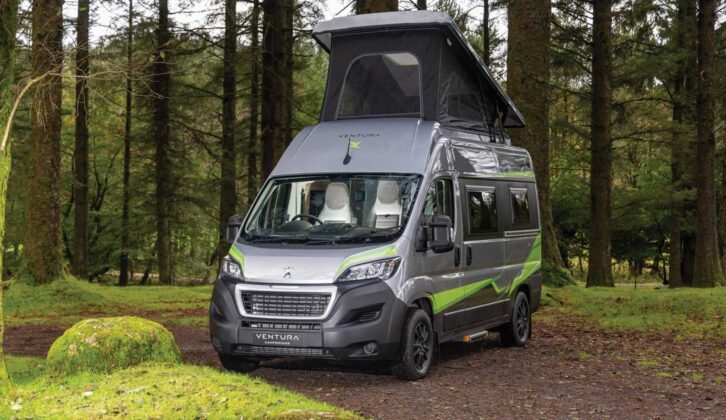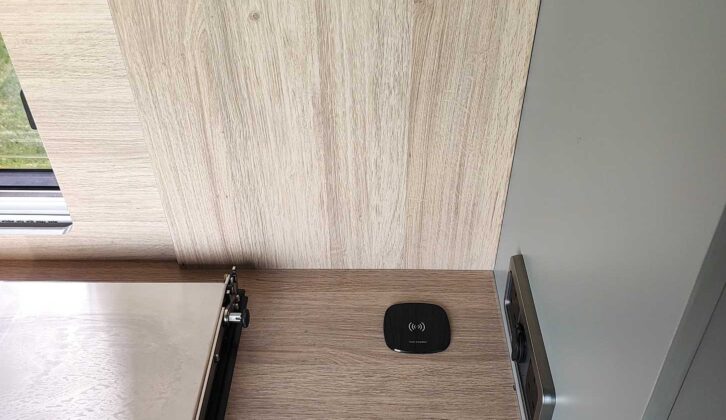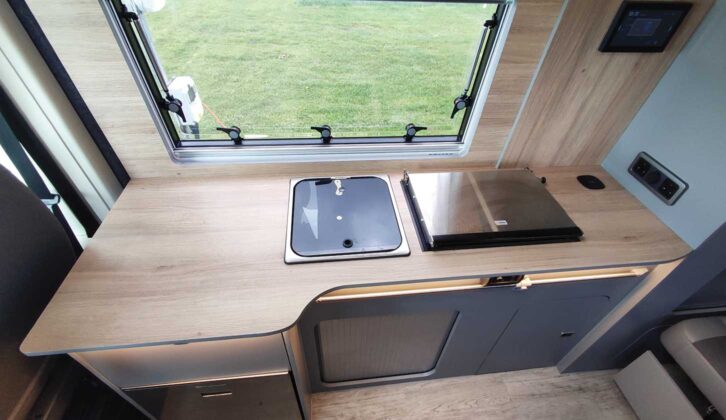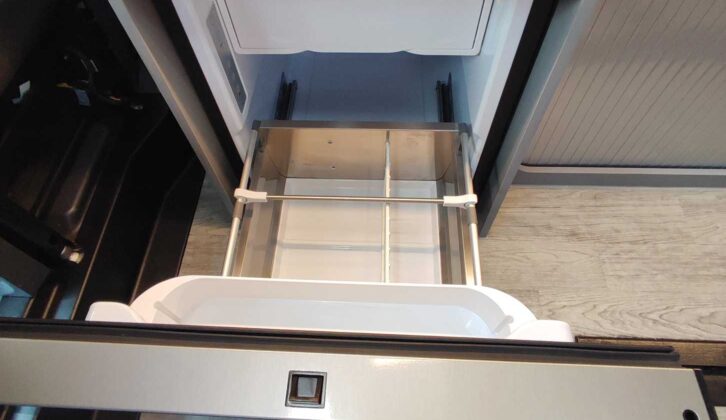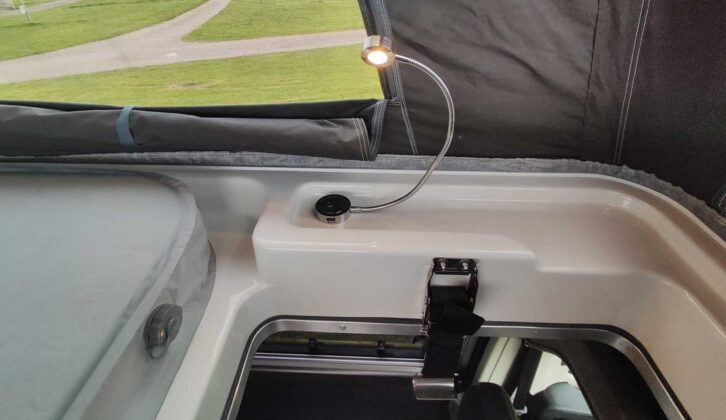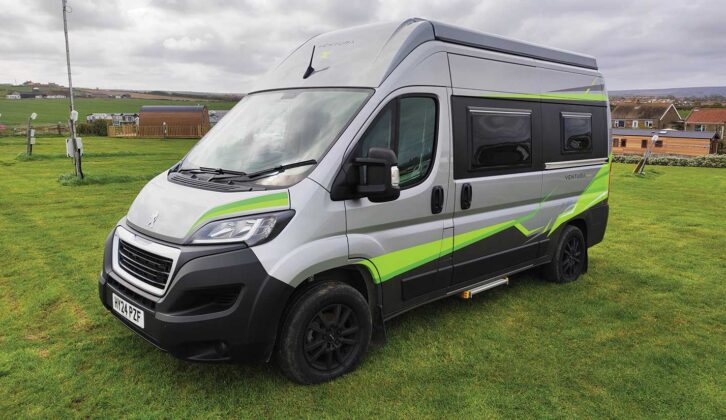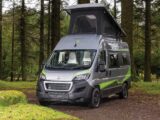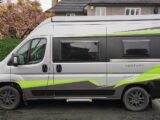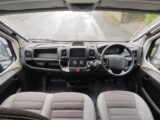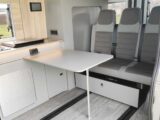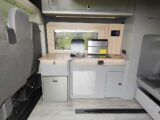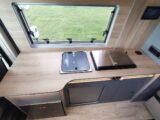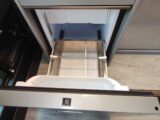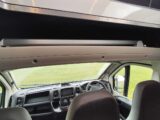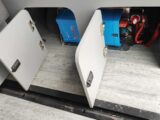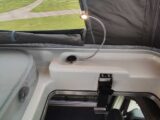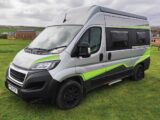Verdict
There’s clearly high demand for off-grid ’vans at the moment, because lots of manufacturers seem to be making them. When you compare it with the competition, the VR400 is very attractively priced, even in Touring spec, and retains a level of comfort that some other off-roaders seem happy to dispense with. The diesel heating system might not be for everyone, but it is very easy to operate and leaves you with much more storage space and overall, a cleaner finish.
Pros
-
Fantastic beds
-
Lovely quiet drive
-
Loads of storage space
Cons
- Double cab seat blocks out light and is not in a great position for the table
Ventura is an offshoot of GM Coachworks, a Devon-based company that has racked up 35 years’ experience of converting Ford, Renault, Peugeot, VW and Iveco vehicles, much of it for the mobility market.
A few years ago, it moved into conversions, and came up with the Ventura VR200, a model which, at the time was possible to buy, for under £30,000 when it was a winner at the 2019 Motorhome of the Year Awards. Even today, after Covid and multiple price rises, the VR200 starts at £48,995.
But now Ventura has come up with a new model, the VR400, which, like the VR200, is based on the Peugeot Boxer, a base vehicle that we consider a worthy contender in the discussion for the best van for a camper conversion. However, it takes things a stage further by being totally gas-free, as well as having a bed on sliding rails to provide additional storage. Plus, all of the cabinet edges are now banded.
The new vehicle comes in three spec levels: Standard, which starts at £59,995 with the ’van as a high-top; Plus, starting at £73,995 and including everything in the Standard, plus the raising-roof with bed, a manual side door step, a reversing camera, mains power hook-up and a microwave; and Touring, which includes all of that plus underslung water tanks, a portable toilet, cab blinds and a lithium battery with an inverter. It starts at £78,995, or £68,995 without the raising-roof.
Either way, with a diesel heating, no gas, a powerful battery and an inverter, it should be worth considering for ‘van owners looking for the best campervan for off-grid camping.
To find out more, I took a Touring model with a raising-roof for a spin along the Yorkshire coast.
Exterior and cab of the Ventura VR400
My test vehicle had a Cumulus Grey exterior, although five other smart colour options are available, including Ice White, Iron Grey, Graphite Grey, Thunder Grey and Volcano Red.
Contrasting with the grey are green decals, which really set this vehicle apart from the other ‘vans I came across on site. The graphics can also be a different colour.
This model of the VR400 is based on the 5.41m-long Boxer, making it a nimble ride and much easier to tuck into parking spaces en route.
The thing that really impressed me while driving the vehicle, however, was the Spanish-made Atek roof.

Often with pop-up roof ’vans, we’ve found that, above a certain speed, there is so much air whistling through the gap between roof and ’van body (even when it is securely fastened)
that it’s tricky to have a conversation with the passenger in the cab.
Either that or the strange rattles keep you a bit nervous about what is going on up there. Here, thanks to the visor installed in front of the roof structure, there was no noise at all, tye type of thoughtful feature we look for from the best campervan conversion companies in the UK.
My test model came with a double passenger seat. With this in place, you have six belted seats. But you can go for a single seat if you prefer, and frankly, I would. The double seat uses up any aisle space, so if you decide to stop off en route for a snack, you have to climb out of the vehicle and go right round to reach the back.

In addition, I found it so close to the driver’s seat that I was frequently plugging my seatbelt into its seatbelt attachment – a mistake you are only alerted to by an ear-splitting alarm which goes off 10 seconds after you move out into traffic.
The double seat itself is also a bit of a devil to swivel, and because of its large headrests, it blocks out a lot of the light that would otherwise come into the rear from the windscreen. This is only the second time I have seen this kind of seat when testing ’vans in recent years, and now I understand why.
By contrast, the three belted seats in the back are very comfortable. Here, you can set the backrest to six different positions, which are all safe to use while travelling. The bench can also slide forward, so the travel experience feels more like that of a car.
The vehicle comes with a manually operated step outside, although it doesn’t really need it. You are meant to be able to prise it open with your feet, although, as a larger-footed tester, I found this tricky to do.
Lounging and dining in the Ventura VR400
This is a Boxer-based ’van, rather than a Transporter or a Transit Custom, so you get over 6ft of headroom inside. The roof is really just for the bed, and in fact can only be accessed through a hatch via a ladder.
This does mean, however, that the daylight you might get coming through the windows in a pop-up roof does not really flood in here.
On my test model, this was perhaps made a bit worse by the grey upholstery and furniture finish; although LEDs in the ceiling, switched striplights down the sides and downlighters underneath the kitchen work surface all helped.
In any case, Ventura prides itself on being bespoke wherever possible, and you can choose from a wide variety of upholstery finishes.
The clip-on table is stored on the inside of one of the barn doors. You can easily reach it and put it back without having to go outside. The long clip-on rail means that you have a choice of positions for the table, but even in its most forward position, it is still some way from the swivelled bench, which is also a step above everything else. The driver’s seat does not swivel.

The ’van’s motorhome heating system sees it come from air blown out of the Wallas heater and hob. When I took the VR400 out in a cold mid-April, I found the heater took a good hour to get everything nice and cosy, even with the raising-roof down. However, it kept the interior pleasantly warm, and the noise from the heater was not intrusive.
The two mains sockets (powered by the inverter) and two USBs are close by, at the end of the worktop. Next to this is the control panel.
Made by Wired Campers, it is very easy to use, thanks to all of the symbols also having text labels.
All windows come with blinds and flyscreens. There are cab blinds, too.
Kitchen in the Ventura VR400
Originally designed for marine use, the neat little Wallas hob in the side kitchen heats up and cools down very effectively indeed.
You really only need two burners in a campervan like this, and with the large workspace to the right of the hob, there is plenty of room for food preparation right where you need it – not to mention two mains sockets close at hand, as well.

The sink, located just to the left, is an adequate width, and usefully deep, too. The clean lines of this whole area make elegant use of the space available, and the kitchen is well lit, with a striplight and natural light from the large window.
The back of the fridge underneath is so much easier to reach than normal, thanks to it being a drawer design. The table doesn’t get in the way, either.

The microwave, also powered by the inverter, is next to this. It’s great to see one in a camper, thanks to the absence of gas bottles. I’d have been tempted to put it higher up, but that might have obscured the window.
Washroom in the Ventura VR400
Like all campervans that feature the traditional ‘VW-style’ campervan layout with a side kitchen, the VR400 doesn’t have a separate washroom. But Touring models are supposed to come with a portable toilet, and although my test model did not have one, I have been told that on production models, the openings on the kitchen unit will be slightly altered so that a Porta Potti 335 can fit under there.
Sleeping in the Ventura VR400
The two double beds in this campervan (if you go for the pop-up roof) are both 1.3m (or 4ft 3in) wide and at least 6ft long. That is probably going to be as good as anything you would get in most low-profile motorhomes.
The roof bed also comes with the luxury of an inflatable mattress. You reach it via a ladder that is stored neatly away in a cubbyhole above the cab, and along with three mesh windows to look out of, you get two swan-neck lights.

The metal fastenings for the roof are some of the sturdiest I have seen, but they are still very easy to use.
The downstairs bed, by FabworX, opens out from the rear seat in rock’n’roll style, with headrests that slot into the rear panel like a jigsaw. I found this a more comfortable bed than some RIBs, as there were fewer hard edge joins or levers to try and prise out.

Having USBs so close was also handy, although due to the higher than average headroom, reaching the LED in the ceiling was a bit of a stretch.
Storage in the Ventura VR400
Not having to accommodate any gas bottles, the paraphernalia of a gas hob or any heating ducting really makes a huge difference when it comes to the storage space in this ’van, something which can otherwise be a pro of going gasless in a motorhome.
There are three capacious overhead lockers, which are all bigger than they look on the outside, and lit, too.

Then a large tambour door (which can come down quite smartly) opens out to reveal a set of shelves and a sizeable hanging wardrobe, which is also accessible from the back if you open the rear doors. The shelves aren’t lit, and on my test model, they were finished in dark grey, making it a bit tricky to work out what was in there.
The large drawer under the bench seat can also be accessed from front and back, and there is space next to it where you can store boots.
There is even a bit of extra space in the cupboard housing the inverter and in the cubbyhole for the ladder.
Kitchen storage, in particular, is very impressive for a camper, with a large drawer above the fridge and another larger cupboard on the right.
For really big items, you can slide the bench seat forward. You need to adjust four locking bolts to do this, which is a little bit fiddly, but at least it means that the seat stays firmly in place once you have repositioned it.
Equipment included
As this campervan is clearly aimed at people who like to go off-grid, it is great to see that it includes an inverter, which powers the mains sockets, while anyone in a camper will find it handy to have a microwave. The provision of USBs and lighting that you switch on and off individually is good, too. But given that this is for off-roaders, an external shower fitting would not go amiss.

Buy if…
You are an active family or couple who don’t want to splash out a fortune on a high-end off-grid campervan, and would happily wait a bit longer for the interior to heat up if that means you get better storage for all of your stuff.
If you’re after a cheaper option, it could be worth finding out about the pros and cons of self-build campervans.
Alternatives to consider
Project Yonder Freedom 4X
- Price: £156,872
Based on a Mercedes Sprinter, this is a niche off-road ’van that debuted at the February NEC Show earlier this year.
WildAx Altair RL
- Price: £102,995
WildAx’s first ’van on a MAN TGE is 1.43m longer than the VR400, with rear lounge and front dinette; it is also gas-free.
Technical data
Base vehicle
- Chassis: Peugeot Boxer L2 H2
- Engine: 2.2-litre 140bhp turbodiesel
- Power: 140bhp@3750rpm
- Torque: 339Nm@1750rpm
- Transmission: Six-speed manual
Features include Cab air conditioning, cruise control, rear parking sensors, front electric windows, electric door mirrors, sat nav, adjustable steering wheel, ESC with Hill Start Assist, ABS braking, remote central locking, driver airbag, daytime running lights, 7in colour touchscreen with Apple Car Play, Android Auto, DAB radio, USB socket and steering wheel-mounted controls, reversing camera
Conversion
Van conversion with double swivelling cab seats (currently including double passenger seat), manual side door step, optional pop-up roof with ladder
Lounging and dining
Swivelling cab seat, rear bench with three belted seats, clip-on table stored in rear barn doors, LED lighting with striplights on both sides and ambient lighting underneath worktop, two sets of USB ports in living area, plus mains sockets. Heated by Wallas diesel-fired combined hob and heater, flyscreens and blinds to all windows, cab blinds (in Touring model), choice of upholstery and furniture finish
Kitchen includes:
Wallas combined two-burner hob and heater, microwave, drawer fridge with freezer compartment, stainless steel sink, extensive worktop with two mains sockets and USB ports, individually switched LED striplight
Bed spec
- Lower bed: 1.82 x 1.30m
- Roof bed: 2.00 x 1.30m
Equipment includes
Wired Campers touchscreen controls, swan-neck lights in roof bed, inverter and lithium battery (on Touring model)
If you’ve enjoyed reading this article, why not get the latest news, reviews and features delivered direct to your door or inbox every month. Take advantage of our brilliant Practical Motorhome magazine SUBSCRIBERS’ OFFER and SIGN UP TO OUR NEWSLETTER for regular weekly updates on all things motorhome related.
Technical Specifications
| Berth | 2 |
| Payload | 929 kg |
| MTPLM | 3500 kg |
| Shipping Length | 5.41 m |
| Width | 2.51 m |
| Engine Size | 2200 cc |
